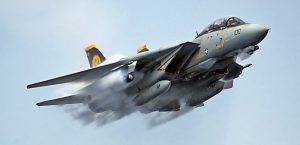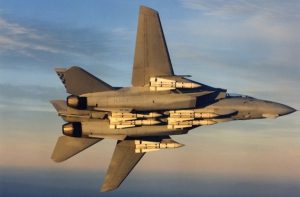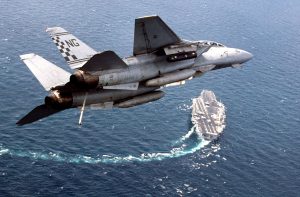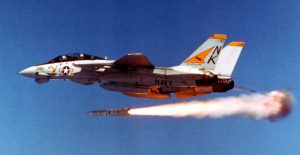Northrop Grumman F-14 Tomcat Fighter Aircraft
The F-14 Tomcat was produced by Northrup Grumman to be the United States Navy’s premier Fleet Air Defense (FAD). It was a two-seat, twin-engine fighter aircraft capable of long distance interception. One of its unique design features was a variable-swept wing which changed its aerodynamic profile. The F-14 Tomcat was also an ideal choice for extremely short take-offs and landings, making it possible to be deployed on board aircraft carriers. Since the F-14 Tomcat’s first deployment aboard the USS Enterprise in 1974, this fighter aircraft served the Navy until 2006. It was formally replaced by the F/A-18C Hornet and the F/A-18E/F Super Hornet.
Maneuverability:
Unique in its design in multiple ways, the aircraft handled amazingly well according to military avionics experts. The pilot, who sat in the front, had a very comprehensive view. A Radar Intercept Operator (RIO) sat in the rear. The RIO did not have duplicate capabilities such as a joystick, so he was very much dependent on the pilot to succeed. For loitering and landing, the variably swept wings maintain a 20º extension but extended out to 68º when the aircraft approached subsonic speeds. For stowage purposes on the aircraft carrier deck, the wings could be retracted up to 75º.

Avionics:
For the majority of its career, the F-14 did not have latent nightvision capability. Night vision goggles were issued to the pilot and radar and other technologies enabled night time operation, but the aircraft itself was not initially equipped with night vision capabilities. At a much later point in the F-14’s career, 82 US Navy F-14Bs were upgraded with a Sparrow Hawk Heads Up Display (HUD) and FV-3000 modular mission display system. This gave the F-14 a much greater degree of autonomy.

Powerful Radar:
The Raytheon AN/APG-71 digital multimode radar enabled the Tomcat to track up to twenty four targets simultaneously and its increased size enabled it to carry a staggering array of air-to-air missiles such as the AIM-54 Phoenix. The Phoenix is considered to be a long range air-to-air missile with an optimal range of 93 miles.
Size:
One of the biggest differences between the F-14 Tomcat and almost any other fighter aircraft the U.S. Navy employs is its size. The F-14 Tomcat was much larger than the F-4 Phantom it replaced. This difference in size can be accounted for the extremely advanced radar system the F-14 employ.

Enhanced Targeting:
Since 1995, F-14s were often equipped with an optional Lockheed Martin’s LANTIRN precision strike navigation pod. This pod gave them a much clearer picture of the battlespace and greatly enhanced their ability to fights day or night.
Fuel:
Internal fuel was spread across five internal tanks with the option to attach two more externally. This made them ideal when operating across the vast swaths of mostly empty ocean and increased their loiter time.

Foreign Sales:
In addition to the U.S. Navy’s extensive use of the F-14, Iran was also an initial purchaser prior to the Iraq-Iran war. That war proved the Tomcat’s fantastic design and the birth of an Iranian pilot ace, Jalil Zandi. Zandi was credited with downing 11 Iraqi fighter jets over the course of the war.
Outside of the Islamic Republic of Iran’s Air Force, all F-14s have been completely scraped. A select few Tomcats are on display in air museums.

Powerplant:
Two General Electric F110-GE-400 after burning turbofans power the F-14 Tomcat, similar in design to those used in the F-16 Falcon and F-15 Eagle. Each turbofan produces a dry thrust of 16,610 lb-ft.
See F-14 Tomcat Specifications
| Length: 62 ft 9 in (19.1 m) |
| Height: 16 ft (4.88 m) |
| Wingspan: 64 ft (19.55 m) when spread, 38 ft (11.58 m) when swept |
| Speed: Mach 2.34 (1,544 mph, 2,485 km/h) |
| Ceiling: 50,000 ft (15,200 m) |
| Maximum Takeoff Weight: 74,350 lb (33,720 kg) |
| strong>Range: 500 nmi (575 mi, 926 km, combat radius |
| Crew: 2; 1 pilot, 1 Radar Intercept Operator |
| Unit cost: $38 million (1998 Adjusted USD) |

